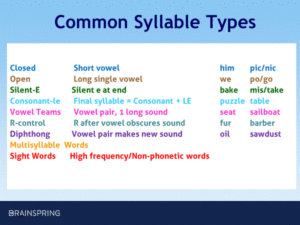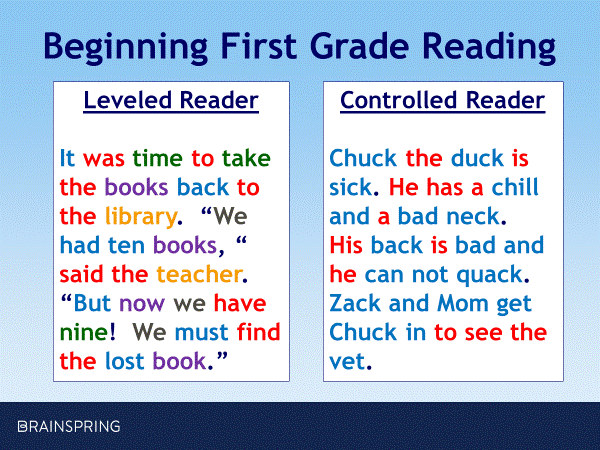The Importance of Controlled Readers
Posted by Stephanie Cork on 18th Oct 2017
What are Controlled Readers?
And Why are they Important to Emerging and Struggling Readers?
Controlled Readers are an excellent resource for beginning and struggling readers, yet they are seldom used in most reading programs. They are extremely effective for helping students gain confidence in reading while also building fluency. Controlled Readers are a series of short stories that typically follow the sequence of skills taught in a particular program. What makes them different from Leveled Readers is that they only contain the skills the student has specifically learned. A Leveled Reader may emphasize a particular skill the student is practicing but they also contain many patterns the student has not learned.
Syllable Patterns
Some of the main syllable patterns that are taught to students are listed below. They are listed in the order of frequency that they are used in the English language.
In Kindergarten, students often start learning the first pattern, the Consonant-Vowel-Consonant pattern (CVC) or closed syllable pattern. These are typically one syllable words with short vowels, like “sit”, “hot” and “pan”. This is the most common syllable type, so it makes sense that we start to teach reading with this pattern.
Leveled Reader vs. Controlled Reader
The next set of pictures shows an example of a Leveled Reader vs. a Controlled Reader. The words in the text are color-coded to match the syllable types listed above. Both contain beginning first grade level text.
At this point, most students have learned the CVC pattern (blue) and a few sight words (red). As you can see, the Controlled Reader (right) has all blue and red words, whereas, the Leveled Reader contains a mix of syllable types, including patterns the student has not learned.
My Story
When my daughter was in Kindergarten, the teacher focused on teaching the CVC pattern. My daughter could read and spell words containing this pattern pretty accurately. She left kindergarten on grade level. Three weeks into first grade, I received a letter stating she was behind in reading and they wanted to pull her out a half hour a day for remediation. I was shocked and berated myself for not working with her more over the summer. I readily agreed to the extra help.
When conference time came around, I saw the reading specialist and asked her what they were working on. She looked at me and said, “short u makes the /u/ sound”. I thought this was odd since my daughter could read and spell words containing short vowels with accuracy. The reading specialist must have noted the expression on my face because she said, “Well your daughter is at a Level 7 and she really should be at a Level 10”. I asked her what was the difference between a Level 7 book and a Level 10 book. She looked at me and asked, “What do you mean?” I wasn’t exactly sure how to reword my question, so I did what many people do, I slowed my words down and enunciated my question more clearly. “What is the skill difference between a Level 7 book and a Level 10 book?” In our program, Phonics First®, three levels would mean the difference between three specific skills. She still didn’t understand my question so I asked her to send me a copy of a Level 7 book and a Level 10 book.
When I took a look at both books I was shocked. I thought, “of course she can’t read these books!” They contained silent-e words, vowel teams, diphthongs; patterns that had not been taught to her yet in the first two months of first grade. To me, this is similar to teaching a child addition and then giving her a worksheet with addition, subtraction, multiplication and division and then saying there is something wrong with the child because she isn’t successful. I found it shocking that this is standard practice with most reading programs!
Today
Fast-forward fifteen years. As a Certified Dyslexia Practitioner and Instructor, I see this scenario happen often. Many of the students we see at our Learning Centers do not have a learning disability; they simply struggle to learn to read the way it is presented. Now don’t get me wrong, I am not against the use of Leveled Readers. But they should be used in conjunction with Controlled Readers. The Leveled Readers give the student the practice they need to read uncontrolled text. Yet, if we truly want to assess students’ reading skills based on the skills we have directly taught, it’s important to provide texts that limit the patterns that have not been taught. And if we want students to practice reading the skills that have been directly taught, then we must provide controlled text.
Controlled Readers are Important!
Controlled Readers can be difficult to find. They are typically part of a particular program and follow the sequence of that program. The good news is most Orton-Gillingham based programs use Controlled Readers and they all follow a similar sequence. At our Learning Centers we use the Controlled Readers that go with our Phonics First® program, however, we supplement them with additional Controlled Readers such as S.P.I.R.E., Wilson, and Alphabet Readers. Over the years, we’ve worked with many struggling and emerging readers. They are often pleasantly surprised to find they can, not only read the controlled text, but that it takes less effort. They start reading more accurately, build speed, and gain confidence. For many students, Controlled Readers are an essential tool for creating fluent readers.
Stephanie Cork, CALP CDP
Stephanie is the Director of Program Development for Brainspring Educator Academy.
Director of Program Development


